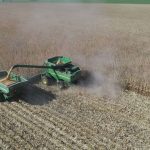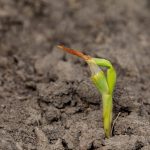What Is No-Till Farming?
What is no-till farming?
The term ‘no-till farming’ is one that has become very topical – trendy even – in recent years. There’s a been a huge rise in the number of farmers curious about what no-till could bring to their soil, their yields, and their farm overheads.
But in fact, the concept of no-till has been around as long as farming itself, since the first human poked a hole in the soil with a stick, and dropped in a seed. As a farming practice, it’s been around in the US since the Dust Bowl of the 1930s – and has become increasingly popular since after WW2.
But what exactly is no-till? Is it one farming practice – or many? How many farmers are doing it? And what does the future of no-till look like? In this blog, we’ll explore the history, the mechanics and the state – current and projected – of no-till farming in the US.

First things first: what is no-till?
No-till farming is fairly self-explanatory – it’s a farming method that involves not tilling the soil. That means no plowing, no ripping, no harrowing – nothing that disturbs the soil structure. When it comes to planting time, seeds are planted through the residue of last year’s crop using seed disc openers to cut a v-shaped trench that is closed at the back of the planter, and the emerging seeds grow up through the residue.
When was no-till first introduced?
The very first farmers used no-till systems. It wasn’t until the invention of the plow in the 1700s that tillage as we know it today became commonplace – in fact, American farmers were initially suspicious of the plow, believing that it poisoned the soil and caused weeds to proliferate.

A soil crisis
By the early 1800s, the idea of horse- or ox-drawn plows had caught on and farmers discovered that by tilling the soil, they could plant seed more quickly and get rid of unwanted plants including grass and weeds from their crop fields. By the early 1900s, rising demand for wheat led to a change in US agricultural policy that rewarded farmers for planting larger and larger acreages, especially in the prairie grasslands of the Midwest. When drought hit in 1930, vast swathes of land were turned into the ‘Dust Bowl’, with millions of tons of topsoil lost and large parts of the region rendered useless for farming.
After that, farmers realised that overplowing of the land could cause more harm than good. In 1935, President Franklin D. Roosevelt introduced the Soil Erosion Service (now known as the Natural Resources Conservation Service) to develop and promote ‘new’ farming techniques – including no-till – to tackle the problem of soil erosion.

How does no-till benefit the soil?
No-till benefits the soil by leaving its natural structures intact. Soils are bound together by organic matter, plant roots, and a complex network of pores and channels that allow water to infiltrate to deeper levels. They are also teeming with life, including larger organisms like earthworms and burrowing insects, and microscopic organisms like bacteria and fungi. These organisms serve to break down organic matter in the soil, like the foliage from dead plants, and convert it into fertilizer for future plant growth.
When the soil is tilled, this delicate ecosystem is disturbed. The soil’s natural structure is destroyed, living organisms die off and organic matter is much slower to break down, so the soil’s natural nutrients get depleted more quickly. The soil loses its ability to effectively store moisture so it becomes very dry, or completely waterlogged depending on climatic conditions – but both cases lead to erosion and soil losses either due to wind or flooding.
No-till systems effectively allow the soil to look after itself, preventing erosion and preserving nutrients for enhanced soil quality and fertility.

Are there different types of no-till system?
No-till is a system on its own, but it’s part of a wider range of farming practices often referred to as ‘conservation tillage’. These methods (for example strip tillage or mulch-till) are aimed at reducing the amount of tillage required, leaving some of the soil structure intact or rotating the parts that are tilled from one year to the next.

How does no-till benefit the farmer?
Aside from the obvious benefits of healthier, more fertile soils on crop yields, no-till systems have a number of labor and cost benefits for farmers.
The workload with no-till is less because the farmer doesn’t need to make multiple passes through the field, first tilling the soil or plowing in residue, and then planting the seed. This means lower labor costs, and more time to spend on other farming tasks. No-till systems also typically have lower machinery and fuel costs – often the only equipment required is a planter, where conventional tillage farmers may use a number of implements to prepare a seed bed before planting.

How many farmers in the US are running no-till systems?
Data from the 2017 Census of Agriculture shows that 37% of tillage acreage in the US is no-tilled – an increase of 2.4% from the previous Census – that equates to 104 million acres under no-till. According to the USDA, the highest percentage of no-till acres are wheat (45%) followed by corn and soybeans.
What is the future for no-till?
Research clearly shows that the number of farmers practicing no-till is growing year-on-year, and this growth is expected to continue. Increased global population and the pressures of a changing climate will mean farmers need to preserve every ounce of fertile soil, and no-till could prove key to this.
A recent study by AGU found that soil is currently being eroded across Midwestern states at a rate of 1mm per year – then modeled what the situation could look like if all farmers adopted no-till. The study found that is every tillage farmer switched to a sustainable method, soil erosion could be completely halted within 100 years, preventing the loss of 9 billion metric tons of fertile soil.
There’s also an interesting debate around whether no-till will be replaced by a broader term like ‘conservation agriculture’ that combines principles of no-till with other conservation farming methods like cover cropping and crop rotation, creating a holistic system that works in harmony with nature to maximize crop yields.

Want to learn more?
If you’re interested in the principles of no-till agriculture and would like to learn more about how it could benefit your farm or those of your customers, we recommend a trip to the National No-Till Conference taking place in Indianapolis in January.
As a title sponsor, Wearparts will be in attendance and there will be opportunities to hear from speakers with advanced expertise in the field of no-till as well as hearing from our sales team about how Wearparts tillage and planting parts are specifically tailored for no-till applications. Registration for the event is now open – for all other queries, don’t hesitate to get in touch.




